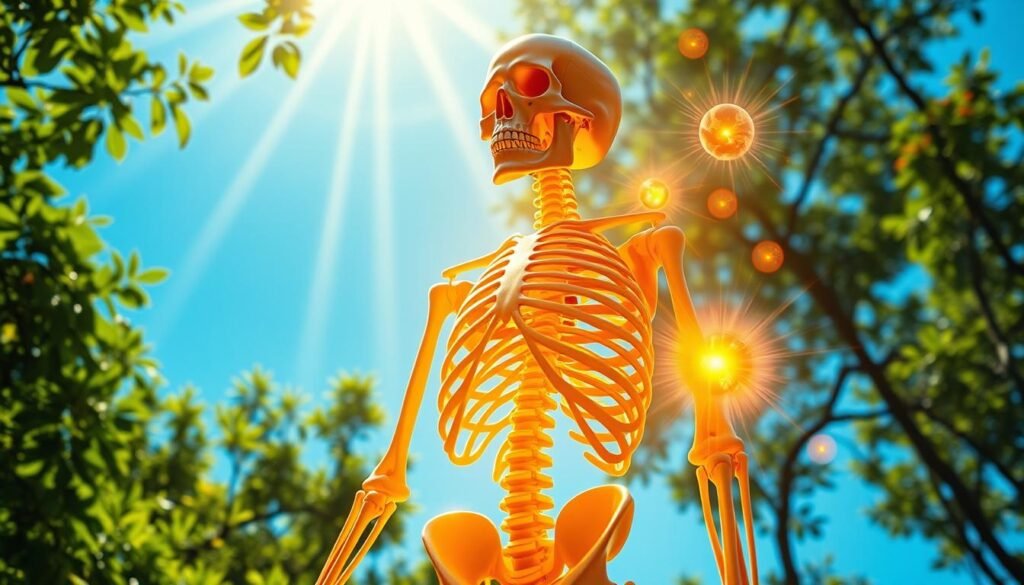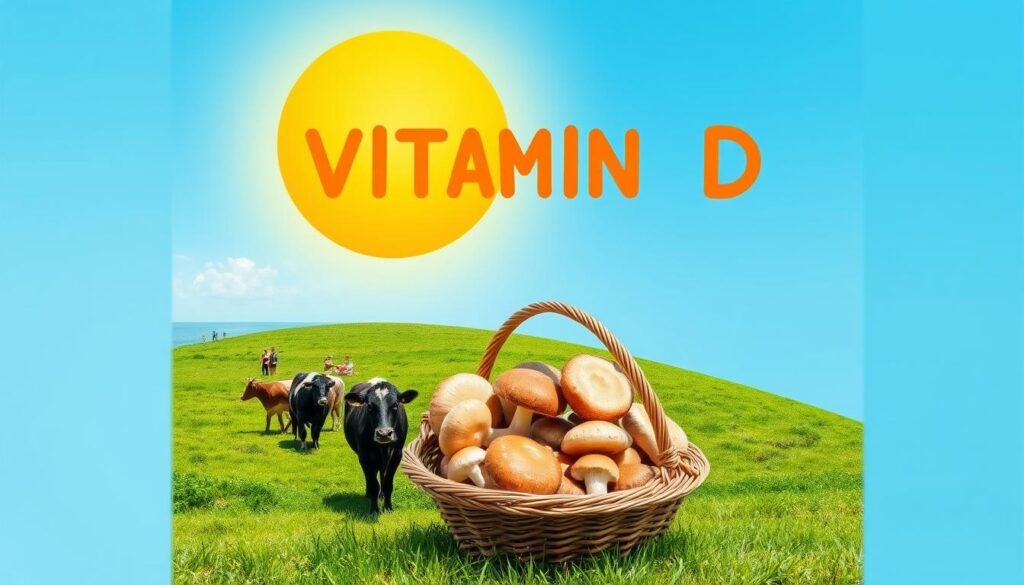Did you know nearly 1 in 5 people worldwide has too little vitamin D? This problem greatly affects bone health. It raises the chances of getting diseases like osteoporosis, which is widespread. Knowing how vitamin D and calcium work together is crucial for keeping bones strong and avoiding issues.
Vitamin D is key because it helps our bodies take in calcium. This is needed for bones to mineralize properly. Not having enough vitamin D can lead to bones becoming less dense. It also ups the risk for breaks and other issues from weaker bones. Everyone should understand how vitamin D and calcium work together for strong and healthy bones.
Want to learn more about vitamins needed for bones? Check out info on essential vitamins for bone health.
Key Takeaways
- Vitamin D is essential for enhancing calcium absorption, crucial for bone strength.
- Osteoporosis can be prevented through adequate vitamin D and calcium intake.
- Children aged 9 to 18 require 1300 mg of calcium and 600 IU of vitamin D daily.
- Adults, depending on age and gender, have specific recommendations for calcium and vitamin D consumption.
- Sources of vitamin D include sunlight, fatty fish, and fortified foods.
- Deficiency in vitamin D can lead to severe bone disorders, particularly in children and aging adults.
Understanding Vitamin D and Its Importance
Vitamin D is crucial for our bodies. It keeps calcium and phosphorus levels in check. Bone health greatly benefits from it, enhancing both mineralization and immune defense.
Getting sunlight helps our skin make vitamin D. About 10 to 15 minutes in the sun a few times weekly does the trick. Eating well also boosts our vitamin D. Foods like fatty fish, beef liver, cheese, and fortified milk and cereal are key sources.
Low vitamin D levels can harm especially older adults. It makes bones fragile and can increase breaks. People over 50, those not getting much sun, or with certain health issues are more at risk. Vitamin D lack is more common in the northern U.S.
People between 1 and 70 years old need 600 IU of vitamin D daily. Over 70s need 800 IU. Taking more than 4,000 IU can cause health problems, like nausea or even kidney issues. Keeping vitamin D and calcium balanced helps fight osteoporosis and lowers bone break risks.
Want to know more about vitamin D? Check out this detailed article for in-depth information.
| Age Group | Recommended Daily Intake (IU) | Upper Limit (IU) |
|---|---|---|
| Infants (up to 12 months) | 400 | Not established |
| Children (1 to 8 years) | 600 | 2,500-3,000 |
| Individuals (9 years and older) | 600 | 4,000 |
| Adults (Over 70 years) | 800 | 4,000 |
The Role of Calcium in Bone Health
Calcium is vital for keeping bones strong. It helps build bone strength, preventing fractures. The importance of calcium in fighting bone diseases like osteoporosis is huge.
It’s crucial to watch how much calcium you get. People over 50 should pay extra attention to avoid low bone mass. They need about 1,200 mg of calcium daily. Adults 19 to 50 should aim for 1,000 mg a day. But, there’s a limit. Too much calcium can be harmful, with the max being 2,500 mg for adults under 50 and 2,000 mg for those over 50.
Eating calcium-rich foods is key. Dairy, like milk, cheese, and yogurt, is packed with it. Dark greens, fish with bones, and fortified foods also add to your calcium intake. Foods like broccoli and fortified cereals are good choices too. They help meet your body’s calcium needs.
The role of calcium goes further than just eating it. Bone density naturally begins to drop by age 35. Taking vitamin D with calcium helps your body absorb it better, boosting bone health. Some people might find it hard to get enough calcium from food alone. They might be lactose intolerant or have certain health issues. In these cases, supplements might be recommended.
| Age Group | Daily Calcium Intake (mg) | Daily Vitamin D Intake (IU) |
|---|---|---|
| Children 9-18 years | 1300 | 600 |
| Adults 19-50 years | 1000 | 400-800 |
| Women 51+ years | 1200 | 800-1000 |
| Men 51+ years | 1000 | 800-1000 |
Keeping up with calcium is crucial for strong bones. Talking to a doctor and checking your diet helps ensure you’re on track. This can make sure you get the right amount of calcium for your bones.
What Does Vitamin D Do for Our Bones?
Vitamin D is key for strong bones and good skeletal health. It helps in many ways, mainly by boosting calcium absorption. Without enough vitamin D, our bodies can’t take in calcium well. This could lead to weaker bones as time goes by.
Enhancing Calcium Absorption
Vitamin D’s role is crucial for absorbing calcium in our intestines. Studies show that without enough vitamin D, children can only absorb 10 to 15% of calcium. This shows how important it is to get enough vitamin D. Babies need 400 IU/day and kids from 1 to 18 need 600 IU/day. This is key to avoid diseases like rickets.
Contributing to Bone Density
Vitamin D also helps with bone density, making bones strong. High levels of vitamin D mean bones are healthier. Foods like farmed rainbow trout and sockeye salmon are great for vitamin D. It’s important to keep vitamin D and calcium levels up. This prevents bone diseases like osteoporosis.
How Vitamin D Affects Bone Development
Vitamin D is key for bone growth at all life stages. Kids need it for normal growth and avoiding rickets. Older adults use it to keep bones strong and lower fracture risks.
Impact on Young Children
Vitamin D is essential for young kids’ bone growth. It helps with calcium absorption, making their bones strong. Not enough vitamin D can cause rickets, making bones soft and weak. Parents need to watch their children’s vitamin D levels for healthy bone growth.
Effects on Aging Adults
As people age, making vitamin D from sunlight gets harder. So, they should eat foods high in vitamin D or take supplements. This vitamin strengthens bones and cuts the risk of fractures in older adults. A good vitamin D level is vital to fight osteoporosis and keep bones healthy.

Vitamin D Deficiency and Its Consequences
Many people around the world don’t get enough Vitamin D. An estimated 1 billion people are affected. This lack can lead to major health problems. For kids, it means rickets, and adults can get osteomalacia. Knowing about these issues helps us keep our bones strong.
Rickets in Children
Rickets impacts how children’s bones grow because they’re not getting enough vitamin D. Their bones can become soft and weak. This might make their legs bow out or cause other bone-related issues. Kids need enough Vitamin D so their bones grow strong and healthy.
Osteomalacia in Adults
Adults can get osteomalacia if they don’t have enough vitamin D. This makes their bones soft, causes pain, and ups the chance of breaking a bone. They might have trouble walking or feel weak. This problem doesn’t just affect bones. It can also make muscles weak and increase fall risks for older people.
| Condition | Population Affected | Consequences |
|---|---|---|
| Rickets | Children | Bone deformities, growth disturbances |
| Osteomalacia | Adults | Weak bones, increased fracture risk |
It’s very important to deal with vitamin D deficiency. Keeping bones strong requires it. By raising awareness and suggesting dietary changes, we can help people get the vitamin D they need. This supports overall bone health.
Sources of Vitamin D
Vitamin D is key for strong bones and overall health. Knowing where to get vitamin D helps people meet their needs. The body makes vitamin D from sunlight. Foods and supplements also play a big part in getting enough.
Natural Sources: Sunlight and Foods
Sun exposure is a great way to get vitamin D. The sun’s uv rays help our skin make this nutrient. But, we must be careful with sun exposure. Too much sun can be harmful, and sunscreen lowers vitamin D production.
We can also get vitamin D from food. Salmon, trout, and swordfish are rich in it. Fortified dairy, egg yolks, and some mushrooms are good sources too. Below is a list of vitamin D levels in some foods:
| Food Source | Vitamin D Content (IU per 3 ounces) |
|---|---|
| Eel | 792 |
| Trout | 645 |
| Salmon (smoked chinook) | 583 |
| Swordfish | 566 |
| Salmon (pink, canned) | 465 |
| Catfish (wild) | 425 |
| Mackerel (Atlantic) | 388 |
Dietary Supplements
Getting enough vitamin D can be hard from sun and food alone. Supplements are a good way to fill the gap. There are two kinds: D2 and D3. D3 is usually the better choice.
Before you start taking supplements, talk to a doctor. They can tell you the right amount to take. For adults under 50, the daily need is 600 IU. For those over 50, it’s 800 IU.
It’s important to get enough vitamin D for bone health. Natural sources and the right supplements can help. For more on vitamin D and bones, click here.

Calcium Absorption and the Skeletal System
Calcium is key for strong bones. It helps them stay dense and tough. For calcium to work, we also need plenty of vitamin D. This vitamin helps our body use calcium from the food we eat.
The Connection Between Calcium and Bone Health
For healthy bones, eating foods rich in calcium and vitamin D matters a lot, especially as we get older. Adults need about 700 mg of calcium a day. Surprisingly, more than half of the women with weak bones don’t have enough vitamin D. This shows how important vitamin D is for absorbing calcium and keeping bones healthy. Studies find that people with enough vitamin D get more calcium than those who don’t.
Preventing Osteoporosis
Stopping osteoporosis starts with getting enough calcium and vitamin D. This is super important for women after menopause, as they lose bone density fast. Adding vitamin D and calcium to your diet can cut the chance of bone breaks by 20% to 30%. By doing this, we can fight against the over 1.3 million fractures that happen in the U.S. every year.
| Vitamin D Status | Calcium Intake (mg) | Risk of Osteoporosis |
|---|---|---|
| Adequate | 943 (whites) / 817 (blacks) | Lower Risk |
| Insufficient | 767 (whites) / 656 (blacks) | Higher Risk |
| Severe Deficiency | Varies | Significantly Higher Risk |
Factors Affecting Vitamin D Synthesis
Vitamin D production in the skin is influenced by many factors. These include where you live, your lifestyle, how old you are, and your skin color. Each factor plays a big role in how well our bodies can make vitamin D.
Geographical and Lifestyle Influences
Different places get different amounts of UVB rays, which affects vitamin D creation. For example, places near the equator get lots of sunlight all year. This means people there can make more vitamin D. But, areas far from the equator get less sun in winter. This can lead to not enough vitamin D during those months. Also, being outside more and whether you wear sunscreen impacts how much vitamin D you can make. People who spend lots of time outside usually get more vitamin D.
Role of Age and Skin Tone
How old you are matters for vitamin D production. As people get older, their skin doesn’t make vitamin D as easily. Also, they might not be outside as much. Skin color also affects this process. Darker skin has more melanin, which makes absorbing UVB rays harder. So, people with darker skin might need more sun to get the same amount of vitamin D as those with lighter skin. Knowing about these factors can help us deal with vitamin D shortages in different groups.

Optimal Vitamin D Intake for Bone Health
It’s important to know how much vitamin D is needed for strong bones. Our body uses it to absorb calcium well and keep bones dense. It is key to follow recommended allowances based on our age for good health.
Recommended Daily Allowances
The National Institutes of Health has guidelines for daily vitamin D:
| Age Group | Daily Intake (mcg) | Daily Intake (IU) |
|---|---|---|
| 0–12 months | 10 mcg | 400 IU |
| 1–70 years | 15 mcg | 600 IU |
| 71 years and over | 20 mcg | 800 IU |
Keeping up with these recommendations helps avoid deficiency. About 35% of people in the U.S. don’t get enough. This issue is really common in Black American kids and babies who only breastfeed.
Potential Risks of Excess Intake
Getting the right amount of vitamin D is crucial, but too much is not good. The limit for people 9 and older is 100 mcg (4,000 IU) a day. Taking more can cause health problems like hypercalcemia and kidney issues. Toxicity is a risk if blood levels go over 125 nmol/L. That’s why it’s important to keep an eye on how much you get from food and supplements.
Conclusion
Vitamin D is key for strong bones because it helps our body use calcium. This article shows that calcium and vitamin D work together for healthy bones. Without enough vitamin D, we could get sick with conditions like rickets or osteoporosis.
Studies show not having enough vitamin D can increase the chance of bone breaks in the elderly. It’s important to get vitamin D from sunlight, food, or supplements to keep bones strong. Taking 800 IU of vitamin D and enough calcium is beneficial for those needing more.
Having enough vitamin D is crucial for not just our bones, but our overall health too. Eating foods rich in vitamin D and calcium, and making healthy choices are key. For more info on vitamin D and bone health, check out this link.